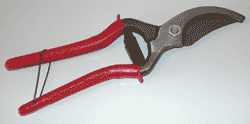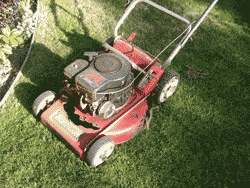| Approach: One
to one |
Level:
Year 4
and year 8 |
|
| Focus:
Rust/corrosion
|
| Resources:
Garden
shears, picture |
 |
1.2Mb |
|
|
| Questions/instructions:
 In
this activity you will be thinking about why some things go rusty. In
this activity you will be thinking about why some things go rusty.
Here is a pair of garden shears.
Hand out garden shears.
|
|
%
responses |
y4 |
y8 |
1.
What parts of the shears could go rusty?
|
said
metal parts (only) |
41 |
41 |
identified
blades |
61 |
61 |
identified
bolt and nut |
37 |
57 |
identified
spring |
25 |
37 |
identified
clip |
23 |
30 |
did
not identify plastic handles |
93 |
95 |
2.
What parts probably won’t go rusty?
|
said
parts not made out of metal/steel/iron |
7 |
9 |
identified
plastic handles |
89 |
92 |
identified
clip |
4 |
5 |
identified
spring |
16 |
11 |
3.
Why won’t the handles go rusty?
|
made
of plastic (which doesn’t rust)
|
76 |
88 |
 Here
is a picture of a rusty lawn mower. Here
is a picture of a rusty lawn mower.
Show picture. |
|
|
4.
What has made this lawn mower go rusty?
|
it
is made of metal (which can rust) |
3 |
7 |
effect
of moisture |
54 |
79 |
effect
of air/oxygen (in combination with moisture) |
3 |
7 |
explicitly
mentioned chemical reaction |
0 |
4 |
5.
How could the owner stop the lawn mower from going rusty?
|
keep
it dry (under cover) |
53 |
76 |
clean
it after use |
24 |
32 |
keep
it well painted/sealed/oiled |
16 |
20 |
6.
How would your idea stop the lawn mower from going rusty?
|
keep
moisture away from bare metal |
30 |
54 |
|
|
|
|
Total
score:
|
11–15
|
2 |
11 |
9–10
|
14 |
29 |
7–8
|
35 |
40 |
5–6
|
35 |
16 |
0–4
|
14 |
4 |
Commentary:
Explanations
for rust and rust prevention were focussed on moisture. About 25 percent
more year 8 than year 4 students scored more than 8.
|